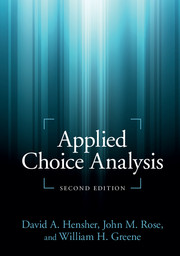Preface
Published online by Cambridge University Press: 05 June 2015
Summary
I’m all in favor of keeping dangerous weapons out of the hands of fools. Let’s start with typewriters.
(Frank Lloyd Wright 1868–1959)Almost without exception, everything human beings undertake involves a choice (consciously or subconsciously), including the choice not to choose. Some choices are the result of habit while others are fresh decisions made with great care, based on whatever information is available at the time from past experiences and/or current inquiry.
Over the last forty years, there has been a steadily growing interest in the development and application of quantitative statistical methods to study choices made by individuals (and, to a lesser extent, groups of individuals or organizations). With an emphasis on both understanding how choices are made and on forecasting future choice responses, a healthy literature has evolved. Reference works by Louviere et al. (2000) and Train (2003, 2009) synthesize the contributions. However while these sources represent the state of the art (and practice), they are technically advanced and often a challenge for both the beginner and practitioners.
- Type
- Chapter
- Information
- Applied Choice Analysis , pp. xxix - xxxPublisher: Cambridge University PressPrint publication year: 2015



